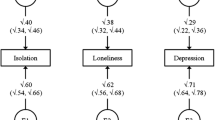Abstract
Research has shown that male homosexuality tends to cluster in families and that homosexual males have, on average, a greater number of older brothers than do heterosexual males. This study investigated whether the former, between-families effect and the latter, within-families effect are additive. The subjects were 717 full siblings over age 40 reported by 343 heterosexual and homosexual male probands examined in Southern Ontario in 1994–1995. The sibling's history of legal marriage or cohabitation in a heterosexual relationship was taken as a proxy variable for sexual orientation. There were no significant findings for the female siblings. As expected, the never-married male siblings were more likely to come from the sibships of the homosexual probands, and they had a greater average number of older brothers. A bootstrapped logistic regression analysis showed that an additive model best explained the male siblings' data. The results suggest that the familial aggregation of male homosexuality cannot be explained by the birth order effect and that older brothers and family membership reflect separate influences on sexual orientation or sexual orientation-correlated behavior.
Similar content being viewed by others
REFERENCES
Bailey, J. M., and Bell, A. P. (1993). Familiality of female and male homosexuality. Behav. Genet.23:313-322.
Bailey, J. M., and Pillard, R. C. (1991). A genetic study of male sexual orientation. Arch. Gen. Psychiat.48:1089-1096.
Bailey, J. M., Willerman, L., and Parks, C. (1991). A test of the maternal stress theory of human male homosexuality. Arch. Sex. Behav.20:277-293.
Blanchard, R., and Bogaert, A. F. (1996a). Homosexuality in men and number of older brothers. Am. J. Psychiat.153: 27-31.
Blanchard, R., and Bogaert, A. F. (1996b), Biodemographic comparisons of homosexual and heterosexual men in the Kinsey interview data. Arch. Sex. Behav.(in press).
Blanchard, R., and Sheridan, P. M. (1992a). Proportion of unmarried siblings of homosexual and nonhomosexual gender-dysphoric patients. Can. J. Psychiat.37:163-167.
Blanchard, R., and Sheridan, P. M. (1992b). Sibship size, sibling sex ratio, birth order, and parental age in homosexual and nonhomosexual gender dysphorics. J. Nerv. Ment. Dis. 180:40-47.
Blanchard, R., and Zucker, K. J. (1994). Reanalysis of Bell, Weinberg, and Hammersmith's data on birth order, sibling sex ratio, and parental age in homosexual men. Am. J. Psychiat. 151:1375-1376.
Blanchard, R., Zucker, K. J., Bradley, S. J., and Hume, C. S. (1995). Birth order and sibling sex ratio in homosexual male adolescents and probably prehomosexual feminine boys. Dev. Psychol.31:22-30.
Blanchard, R., Zucker, K. J., Cohcn-Kettenis, P. T., Gooren, L. J. G., and Bailey, J. M. (1996). Birth order and sibling sex ratio in two samples of Dutch gender-dysphoric homosexual males. Arch. Sex. Behav.(in press).
Bogaert, A. F., and Blanchard, R. (1996). Physical development and sexual orientation in men: Height, weight, and age of puberty differences. Person. Indiv. Diff.(in press).
DeMaris, A. (1992). Logit Modeling: Practical Applications(Sage University Paper Series on Quantitative Applications in the Social Sciences, Series No. 07-086), Sage, Newbury Park, CA.
Efiron, B., and Tibshirani, R. J. (1993). An Introduction to the Bootstrap, Chapman & Hall, New York.
Epstein, R., Sham, G., Womack, J., Yague, J., Palmer, E., and Cohn, M. (1986). The cytotoxic T cell response to the male-specific histocompatibility antigen (H-Y) is controlled by two dominant immune response genes, one in the MHC, the other in the Tara-locus. J. Exp. Med.163: 759-773.
Fierz, W., Brenan, M., Miillbacher, A., and Simpson, E. (1982). Non-H-2 and H-2-linked immune response genes control the cytotoxic T-cell response to H-Y. Immwiogenetics15:261-270.
Gasser, D. L., and Silvers, W. K. (1972). Genetics and immunology of sex-linked antigens. Adv. fmmunol.15:215-247.
Hamer, D. H., Hu, S., Magnuson, V. L., Hu, N., and Pattatucci, A. M. L. (1993). A linkage between DNA markers on the X-chromosome and male sexual orientation. Science261: 321-327.
Hamilton, L. C. (1992). Regression-with Graphics: A Second Course in Applied Statistics, Brooks/Cole, Pacific Grove, CA.
Hare, E. H., and Moran, P. A. P. (1979). Parental age and birth order in homosexual patients: A replication of Slater's study. Br. J. Psychiat.134:178-182.
Hu, S., Pattatucci, A. M. L., Patterson, C., Li, L., Fulker, D. W., Cherny, S. S., Kruglyak, L., and Hamer, D. H. (1995). Linkage between sexual orientation and chromosome Xq28 in males but not in females. Nature Genet.11:248-256.
Hurme, M., Chandler, P. R., Hetherington, C. M., and Simpson, E. (1978). Cytotoxic T-cell responses to H-Y: Correlation with the rejection of syngeneic male skin grafts. J. Exp. Med.147:768-775.
Kirk, R. E. (1982). Experimental Design: Procedures for the Behavioral Sciences, 2nd ed., Brooks/Cole, Monterey, CA.
Mooney, C. Z., and Duval, R. D. (1993). Bootstrapping: A Nonparametric Approach to Statistical Inference (Sage University Paper Series on Quantitative Applications in the Social Sciences, Series No. 07-095), Sage, Newbury Park, CA.
Pillard, R. C., Poumadere, J., and Carretta, R. A. (1981). Is homosexuality familial? A review, some data, and a suggestion. Arch. Sex. Behav. 10:465-475.
Pillard, R. C., and Weinrich, J. D. (1986). Evidence of familial nature of male homosexuality. Arch. Gen. Psychiat.43: 808-812.
Pole, D., and Simpson, E. (1983), Genetic control and effector cells in host-versus-graft responses to H-Y antigen in mice. Transplantation36:546-551.
Slater, E. (1962). Birth order and maternal age of homosexuals. Lancet1:69-71.
Whitam, F. L., Diamond, M., and Martin, J. (1993). Homosexual orientation in twins: A report on 61 pairs and three triplet sets. Arch. Sex. Behav.22:187-206.
Zucker, K. J., and Blanchard, R. (1994). Reanalysis of Bieber et al.'s 1962 data on sibling sex ratio and birth order in male homosexuals. J Nerv. Ment. Dis.182:528-530.
Author information
Authors and Affiliations
Rights and permissions
About this article
Cite this article
Blanchard, R., Bogaert, A.F. Additive Effects of Older Brothers and Homosexual Brothers in the Prediction of Marriage and Cohabitation. Behav Genet 27, 45–54 (1997). https://doi.org/10.1023/A:1025663325313
Issue Date:
DOI: https://doi.org/10.1023/A:1025663325313




